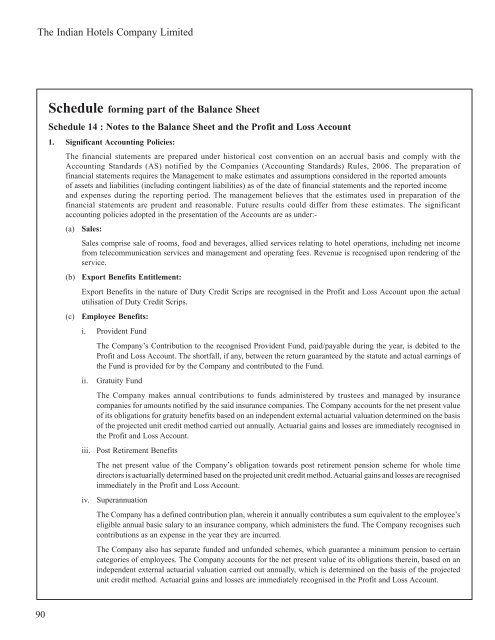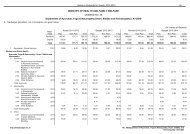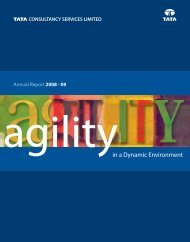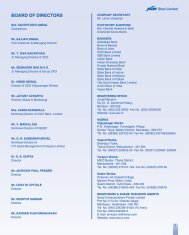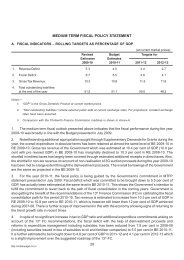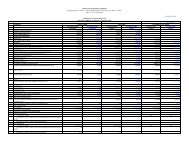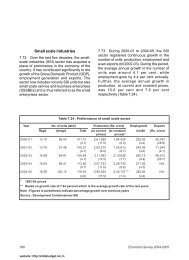Scheduleforming part of the Balance Sheet - Domain-b
Scheduleforming part of the Balance Sheet - Domain-b
Scheduleforming part of the Balance Sheet - Domain-b
Create successful ePaper yourself
Turn your PDF publications into a flip-book with our unique Google optimized e-Paper software.
The Indian Hotels Company Limited<br />
90<br />
Schedule forming <strong>part</strong> <strong>of</strong> <strong>the</strong> <strong>Balance</strong> <strong>Sheet</strong><br />
Schedule 14 : Notes to <strong>the</strong> <strong>Balance</strong> <strong>Sheet</strong> and <strong>the</strong> Pr<strong>of</strong>it and Loss Account<br />
1. Significant Accounting Policies:<br />
The financial statements are prepared under historical cost convention on an accrual basis and comply with <strong>the</strong><br />
Accounting Standards (AS) notified by <strong>the</strong> Companies (Accounting Standards) Rules, 2006. The preparation <strong>of</strong><br />
financial statements requires <strong>the</strong> Management to make estimates and assumptions considered in <strong>the</strong> reported amounts<br />
<strong>of</strong> assets and liabilities (including contingent liabilities) as <strong>of</strong> <strong>the</strong> date <strong>of</strong> financial statements and <strong>the</strong> reported income<br />
and expenses during <strong>the</strong> reporting period. The management believes that <strong>the</strong> estimates used in preparation <strong>of</strong> <strong>the</strong><br />
financial statements are prudent and reasonable. Future results could differ from <strong>the</strong>se estimates. The significant<br />
accounting policies adopted in <strong>the</strong> presentation <strong>of</strong> <strong>the</strong> Accounts are as under:-<br />
(a) Sales:<br />
Sales comprise sale <strong>of</strong> rooms, food and beverages, allied services relating to hotel operations, including net income<br />
from telecommunication services and management and operating fees. Revenue is recognised upon rendering <strong>of</strong> <strong>the</strong><br />
service.<br />
(b) Export Benefits Entitlement:<br />
Export Benefits in <strong>the</strong> nature <strong>of</strong> Duty Credit Scrips are recognised in <strong>the</strong> Pr<strong>of</strong>it and Loss Account upon <strong>the</strong> actual<br />
utilisation <strong>of</strong> Duty Credit Scrips.<br />
(c) Employee Benefits:<br />
i. Provident Fund<br />
The Company’s Contribution to <strong>the</strong> recognised Provident Fund, paid/payable during <strong>the</strong> year, is debited to <strong>the</strong><br />
Pr<strong>of</strong>it and Loss Account. The shortfall, if any, between <strong>the</strong> return guaranteed by <strong>the</strong> statute and actual earnings <strong>of</strong><br />
<strong>the</strong> Fund is provided for by <strong>the</strong> Company and contributed to <strong>the</strong> Fund.<br />
ii. Gratuity Fund<br />
The Company makes annual contributions to funds administered by trustees and managed by insurance<br />
companies for amounts notified by <strong>the</strong> said insurance companies. The Company accounts for <strong>the</strong> net present value<br />
<strong>of</strong> its obligations for gratuity benefits based on an independent external actuarial valuation determined on <strong>the</strong> basis<br />
<strong>of</strong> <strong>the</strong> projected unit credit method carried out annually. Actuarial gains and losses are immediately recognised in<br />
<strong>the</strong> Pr<strong>of</strong>it and Loss Account.<br />
iii. Post Retirement Benefits<br />
The net present value <strong>of</strong> <strong>the</strong> Company’s obligation towards post retirement pension scheme for whole time<br />
directors is actuarially determined based on <strong>the</strong> projected unit credit method. Actuarial gains and losses are recognised<br />
immediately in <strong>the</strong> Pr<strong>of</strong>it and Loss Account.<br />
iv. Superannuation<br />
The Company has a defined contribution plan, wherein it annually contributes a sum equivalent to <strong>the</strong> employee’s<br />
eligible annual basic salary to an insurance company, which administers <strong>the</strong> fund. The Company recognises such<br />
contributions as an expense in <strong>the</strong> year <strong>the</strong>y are incurred.<br />
The Company also has separate funded and unfunded schemes, which guarantee a minimum pension to certain<br />
categories <strong>of</strong> employees. The Company accounts for <strong>the</strong> net present value <strong>of</strong> its obligations <strong>the</strong>rein, based on an<br />
independent external actuarial valuation carried out annually, which is determined on <strong>the</strong> basis <strong>of</strong> <strong>the</strong> projected<br />
unit credit method. Actuarial gains and losses are immediately recognised in <strong>the</strong> Pr<strong>of</strong>it and Loss Account.


